
How to choose a Miscanthus?
Our advice to choose varieties suited to your garden
Contents
Miscanthus, known as “maiden grass” or eulalias are very on-trend in gardens, whether natural or refined. These large ornamental grasses with silky inflorescences immediately add a great deal of structure and character to outdoor spaces! Native to China, Miscanthus with semi-persistent foliage are among the most interesting grasses to plant: very hardy, they thrive in all soils and enliven sunny wild areas or structured borders. Dazzling shimmer of the inflorescences, multiple and changing foliage colours, sizes, flowering periods, uses… each has distinct characteristics to consider depending on what you want in the garden.
Have you decided to plant one or more Miscanthus, so charmed by the atmosphere they create, between lightness and a bold character? Discover our buying guide to help you find your way among the hundred or so varieties available, so you can choose the Miscanthus best suited to your garden.
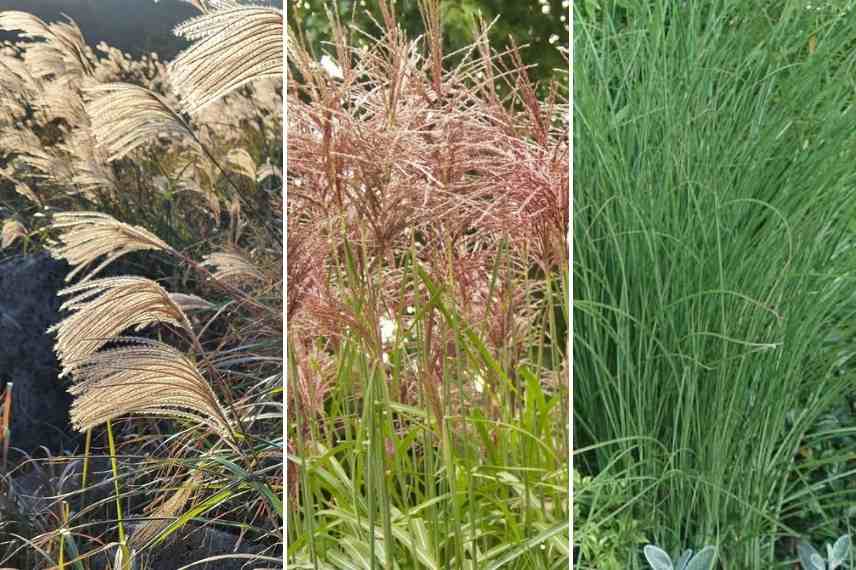
Miscanthus nepalensis, Miscanthus sinensis ‘Malepartus’, Miscanthus sinensis ‘Gracillimus’
→ Discover our comprehensive guide on Miscanthus.
Depending on its habit
Zebra grass, another name for Miscanthus, are plants with a very graceful, flexible habit: their culms (stems in grasses) are tall and slender, rising from soil in dense clumps. Tips of the strap-like leaves often arch like a fountain. Miscanthus will spread more or less in width depending on variety, showing varied volumes and shapes. Some Miscanthus have a rather massive form, due to broader leaves, and are therefore used as screens.
Varieties with finer leaves fit perfectly into naturalised beds alongside large perennials such as Miscanthus transmorrisonensis. Miscanthus sinensis ‘Gracillimus’ is grown more for its very fine, graceful foliage than for its sparse flowering.
The Miscanthus sinensis ‘Strictus’ has a narrow habit (1 m spread) as does Miscanthus sinensis ‘Ghana’, which will not exceed 70 cm in span. ‘Little Zebra’ has a very upright habit, ‘Graziella’ an erect, compact silhouette, and ‘Gracillimus’ retains a very upright habit.
Rounded, bushy and trailing habits are perfect for small spaces: Miscanthus sinensis ‘Adagio’ for example or ‘Yaku Jima’. As for ’Silberfeder’, it stands out with white inflorescences shown to great effect above the foliage.
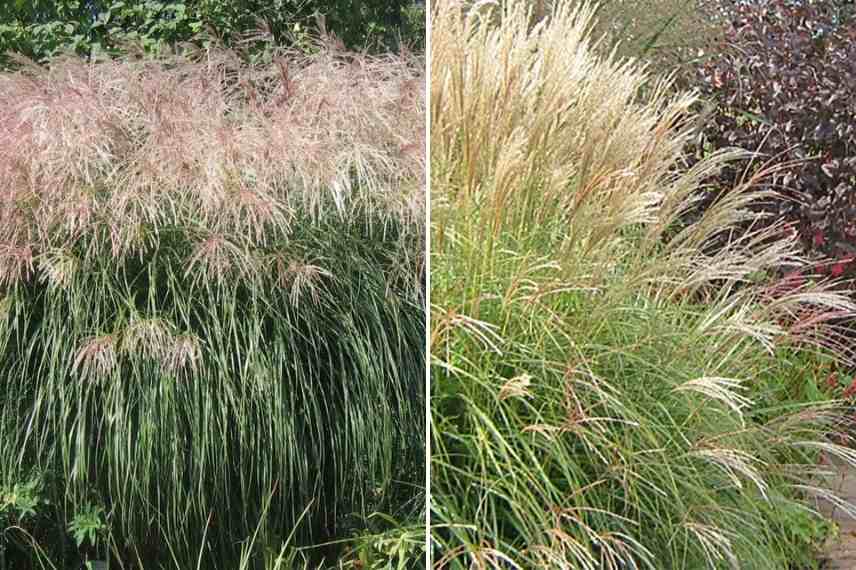
Miscanthus sinensis ‘Graziella’ and Miscanthus sinensis ‘Yakujima’
Depending on its dimensions
Miscanthus are prized for their large size. Around twenty species are considered “giant” because of their exceptional dimensions, but heights generally range between 1.5 m and 2 m, noting that some Miscanthus remain small. (NB: heights given are always for the flowering period):
The largest are truly sculptural, Miscanthus ‘Giganteus’ (or floridulus) easily reaching 3 m provides a lush effect; Miscanthus sinensis ‘Silberfeder’ at about 2.5 m with silvery inflorescences, Miscanthus sinensis ‘Roland’, with broad foliage and inflorescences, grows to 2.2 m and spreads to 1.5 m wide. Miscanthus sinensis ‘Cabaret’ reaches 2.5 m.
You may instead wish to invest in low-growing varieties (between 90 cm and 1.3 m in flower) to adorn a small garden in beds near a terrace or in containers: choose Miscanthus sinensis ‘Adagio’ (1 m), Miscanthus sinensis ‘Morning Bright’, or Miscanthus sinensis ‘Yaku Jima’, both under 1 m. ‘Little Miss’, at 80 cm with reddish foliage, is the perfect candidate for container growing, as are ‘Gold Bar’ with gold-striped foliage, and ‘Kleine Silberspinne’. (also read How to grow a Miscanthus in a pot?).
Bear in mind that your Miscanthus will reach its adult size in about 3 years.
Read also: Miscanthus: a selection of varieties for pots.

Miscanthus ‘Giganteus’ (or floridulus) on the left in the background, and Miscanthus sinensis ‘Little Miss’
Discover other Miscanthus
View all →Available in 0 sizes

Available in 2 sizes
Available in 3 sizes
Available in 1 sizes
Available in 1 sizes
Available in 1 sizes
Available in 2 sizes
Available in 2 sizes
Available in 1 sizes
Available in 3 sizes
By flowering period
Miscanthus flower from late summer to autumn, and brighten gardens with their attractive presence through winter until the following spring (do not prune them before then). Flowering begins in July for the earliest varieties (Miscanthus sinensis ‘Ferner Osten’ and Miscanthus nepalensis) which you will favour in harsh climates to enjoy them fully, and for most varieties in August and September.
Some varieties are much later since they begin flowering from September or October (so should be avoided in northern France and in cold climates): Miscanthus ‘Giganteus’, Miscanthus sinensis ‘Etincelle’, Miscanthus sinensis ‘Grosse Fontäne’, Miscanthus sinensis ‘Gracillimus’, Miscanthus sinensis ‘Sirene’).
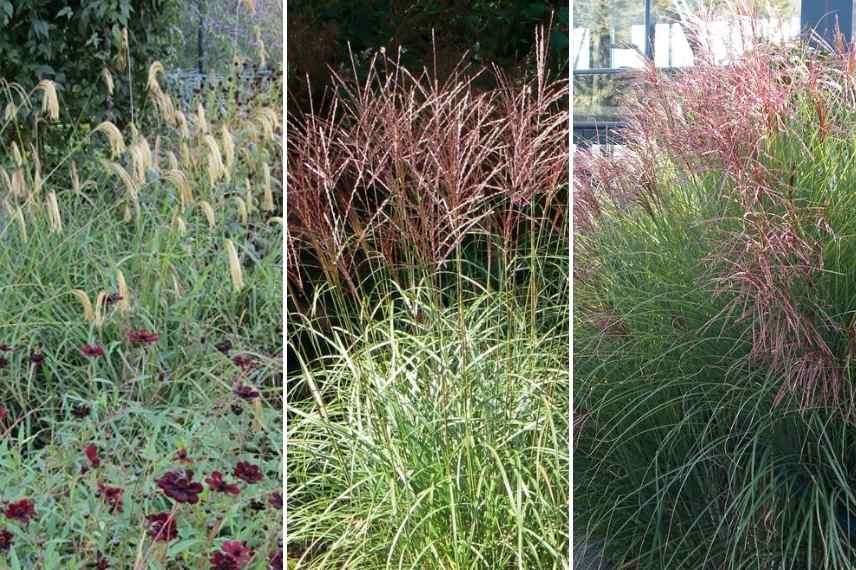
Miscanthus nepalensis (Photo: L. Enking) and ‘Ferner Osten’ are among the earliest in July. ‘Gracillimus‘ (Photo A. Zharkikh) will flower from September
Read also
9 ideas for pairing MiscanthusDepending on the colour of its inflorescences
Spectacular flowering of Miscanthus is their main attraction, it remains on plants in winter, dressing your garden during bleak season. Feathery spikelets open into loose panicles, cream, silver, golden or reddish, often changing over months, which makes this flowering doubly interesting.
- Silver spikelets : copper or red Miscanthus take on this colour at end of season (see below)
- Golden-yellow spikelets : Miscanthus nepalensis with superb old-gold-coloured spikelets becoming white
- Beige or pinkish spikelets : ’Ferner Osten’ and Miscanthus sinensis ‘Purpurascens’ then silver at ripeness, ‘Strictus’ turning cream, ‘Graziella’ becoming silver, ‘Giganteus’, Miscanthus transmorrisonensis beige-pink turning silver in autumn, ‘Adagio’ turning cream as it fades, ‘Arabesque‘ pink with silvery highlights finishing cream…
- Copper-bronze red : ‘Sarabande’ (then turns golden-yellow in autumn), ‘Gracillimus’, ‘Morning Light’…
- Bordeaux/purple reds turning to silvery white : ‘Dronning Ingrid’, ‘Ferner Osten’, ‘ Kleine Silberspinne’, ‘Grosse Fontäne’, Misancuthus sinensis ‘Sirene’
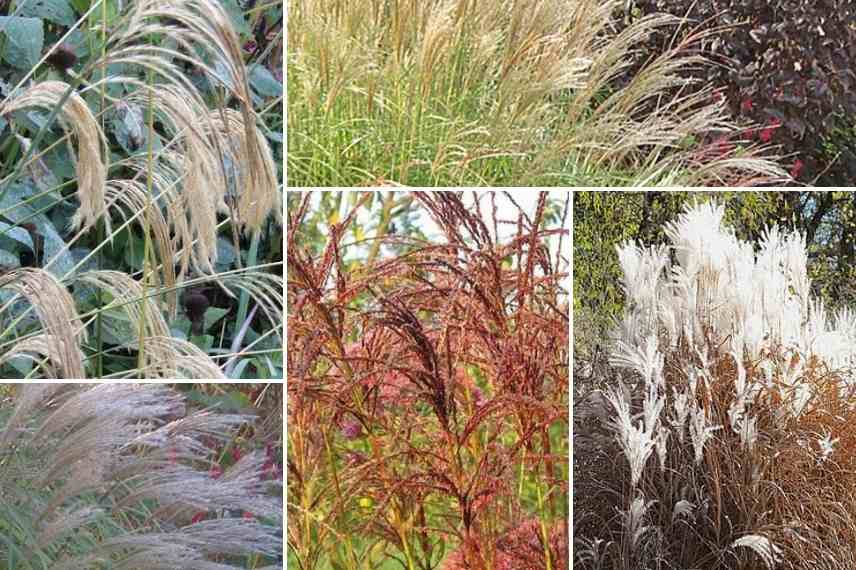
Sublime tones! From top left to bottom right: Miscanthus nepalensis (Photo: L. Enking), ‘Yaku Jima’, ‘Adagio’, ‘Sarabande’ and Miscanthus sinensis ‘Purpurascens’
By foliage colour
Most Miscanthus have a plain foliage where green predominates, which is always very subtly striate. Some are beautifully variegated with cream or yellow. As with flowering, foliage is very often changeable in summer and especially in autumn :
- Light to medium green : Miscanthus transmorrisonensis, ‘Gracillimus’ (turning bronze), ‘Graziella’ (turning coppery)
- Olive green : ‘Dronning Ingrid’ becoming purplish red in September, ‘Ferner Osten’ turning to coppery burgundy in autumn
- Silvery : ‘Adagio’ becoming purple in autumn, ‘Morning Light’ very bright and elegant with fine silvery white stripes
- Variegated : Miscanthus sinensis ‘Variegatus’ a classic with wide leaves striped with white bands, a pale green, Miscanthus sinensis ‘Zebrinus’ and Miscanthus sinensis ‘Gold Bar’, Miscanthus sinensis ‘Strictus’ a lovely acid green variegated with gold
- Reds : Miscanthus sinensis ‘Little Miss’ is first green, then orange, red and finally purple in autumn
- Chocolate purple : ‘Ghana’
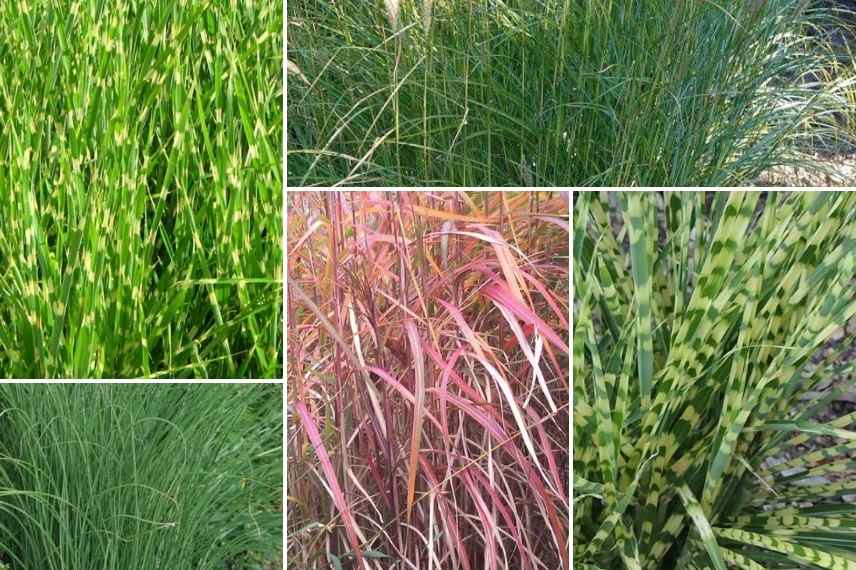
From top left to bottom right : Miscanthus sisensis ‘Strictus’, Miscanthus sinensis ‘Gracillimus’, Miscanthus transmorrisonensis, Miscanthus sinensis ‘Ghana’, Miscanthus sinensis ‘Gold Bar’
Depending on its autumn colours
Ever-changing, many Miscanthus adopt warm colours, tawny coppery to purple, often multicoloured, with first frosts, both in foliage and flowering. These hues are beautifully showcased when the sun’s lower rays caress them at this time of year. Among cultivars of particular interest:
For their autumn foliage: Miscanthus sinensis ‘Purple Fall’, Miscanthus sinensis ‘Ghana’, dressing in warm autumn colours ranging from red to orange and purple, and Miscanthus Sinensis ‘Purpurascens’, with green foliage turning coppery purple in August.
For their autumn flowering: Miscanthus sisensis ‘Ghana’ with spikelets purplish-pink then silvery brown.
According to its hardiness
Although hardy, Miscanthus are not all equally cold-resistant. Some tolerate temperatures down to −25 °C, making them suitable for planting in France’s coldest regions. Miscanthus ‘Arabesque’, ‘Berlin’, ‘Sarabande’ and ‘Gracillimus’ are among the hardiest; ‘Roland’ and ’Adagio’ will also establish well in cold regions.
Depending on exposure
Miscanthus need warmth to produce their terminal flowers. Plant in full sun. Some will only be able to unfurl their extraordinary plumes with plenty of heat, such as giant Miscanthus floridulus. A few of them tolerate light partial shade, such as ‘Kleine Fontäne’ and ‘Morning Light’.
For various uses
Decorative for more than eight months a year, Miscanthus lend themselves to many uses in the garden! With their graphic appearance and erect habit, they can occupy very contemporary spaces as well as wild ones: within beds, in a dry garden, in a winter garden, in hedges, in containers, even in an exotic-style garden!
- Modern garden : by playing on symmetry, plant either side of a path or drive to create a strong perspective. Smaller cultivars, combined with cushion-form grasses (fescues), create a very pure, graphic atmosphere. Miscanthus sinensis ‘Gnom’ and ‘Adagio’ are excellent cultivars for a contemporary garden.
- Natural garden : for wild areas, try Miscanthus Sinensis ‘Africa’, stunning in autumn with its orange tussocks, or Miscanthus transmorrisonensis, which integrates beautifully on a bocage boundary, for example.
- Beds and mixed borders : choice is vast here; all are suitable for enhancing borders and beds depending on height.
- As a specimen : single Miscanthus planted along a path or terrace dresses it with character. Several grouped on a short grass meadow break monotony.
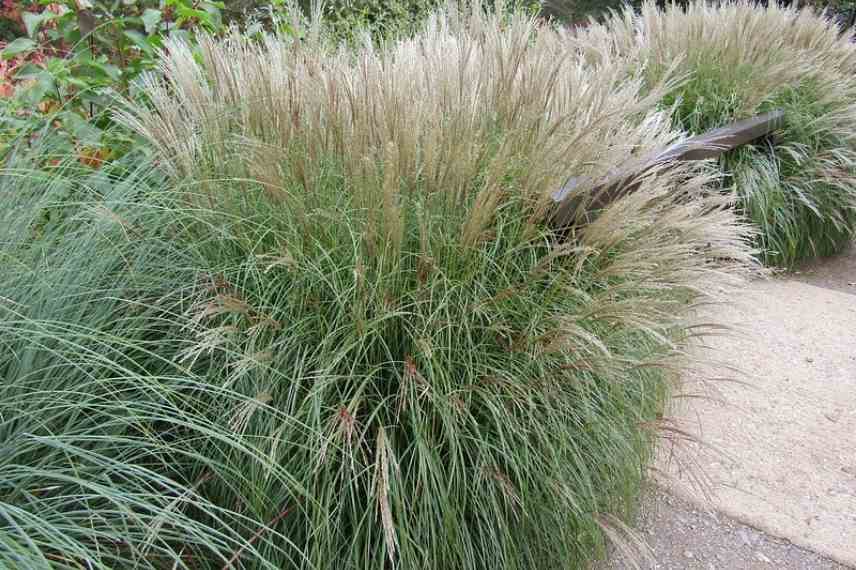
Miscanthus sinensis lining a path (Photo: L. Enking)
- As windbreak or privacy hedge : the height and compact habit of Miscanthus make them suitable for windbreak hedges. They can also hide an unattractive view, form a screen at the bottom of the garden and become effective privacy screens. The Miscanthus floridulus is perfect for this use, paired for example with giant reed. Lower-growing, Miscanthus sinensis ‘Gracillimus’ forms beautiful compact hedges with no maintenance!
- Dry garden : they are also ideal as a focal point in a mineral dry garden, combined with thyms, lavenders, cistus, fescues, santolina and other Euphorbias…
- Winter garden : frost-coated, Miscanthus become enchanting, especially in a winter garden made of remarkable bark, conifers, winter-flowering shrubs (Hamamelis, Chimonanthus, Edgeworthias…) and heathers. They bring a very soft light with their silvery inflorescences and straw-yellow culms.
- Exotic-style garden : give a touch of distant garden or near-tropical atmosphere by choosing varieties with broader or striped leaves or purple tones, paired with bananas or flamboyant Cannas! Try ‘Gold Bar’, ‘Little Zebra’, ‘Gold Breeze’ (striped turning red), ‘Ghana’ or ‘Purpurascens’.
- In containers : choose compact varieties such as ‘Adagio’, ‘Sioux’, ‘Gnom’, ‘Kleine Silberspinne’ with fine foliage to complete a container garden on your terrace.
- Pondside : some Miscanthus can even be planted near a pond where they provide height and originality; Miscanthus sinensis ‘Variegatus’ or ‘Purpurascens’ are ideal for this use, surrounded for example by water iris and Darmera peltata.
- … as mulch : miscanthus mulch helps retain soil freshness and is very ornamental with its pale colour on beds. Use it when pruning culms!
Finally, Miscanthus make very beautiful dried bouquets for decorating interior spaces.
Find our ideas for combinations to compose stunning garden scenes with your Miscanthus.

According to its root system
Miscanthus never become invasive; they form fairly well-defined clumps, growing concentrically. However, it is important to distinguish between tufted and rhizomatous forms. The Miscanthus sinensis, the best-known and most widely used, is a tufted (non-running) grass with short rootstocks that do not cause problems. Rhizomatous forms develop horizontally, producing underground roots. This is particularly the case for Miscanthus sacchariflorus.
- Subscribe!
- Contents
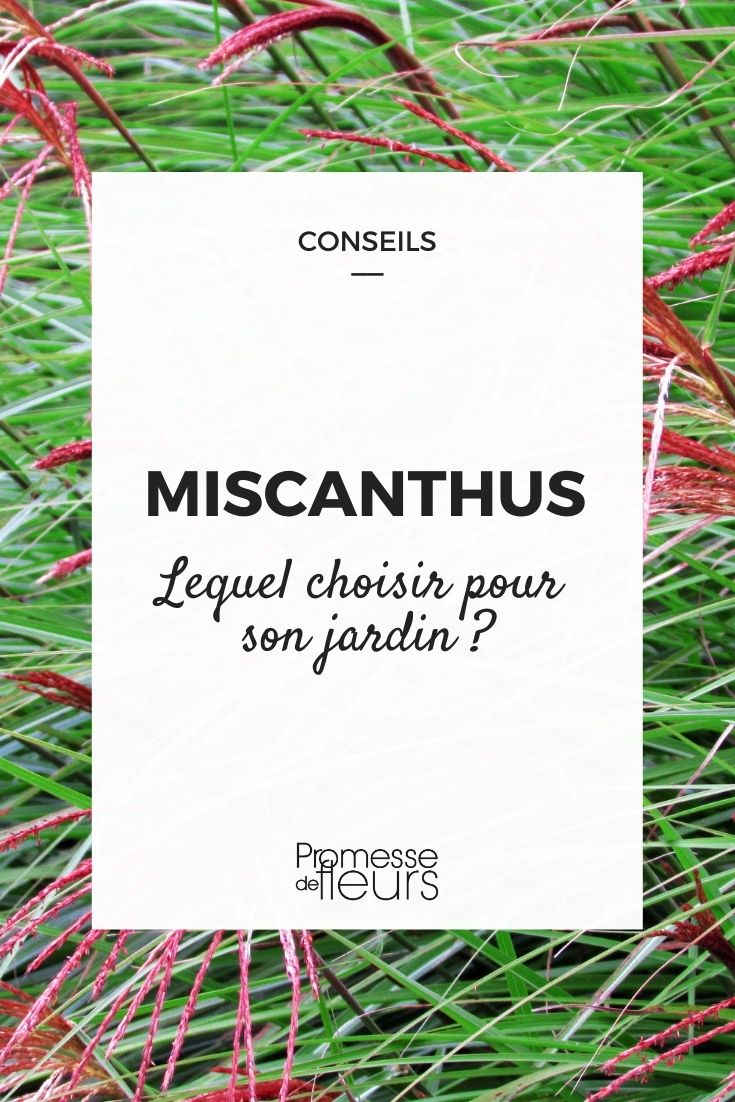































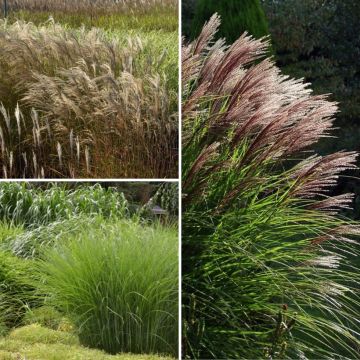
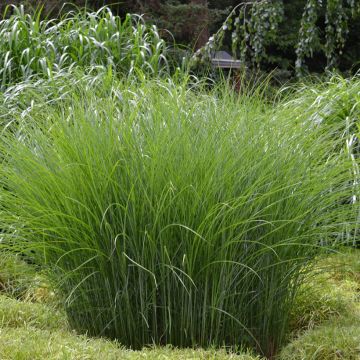
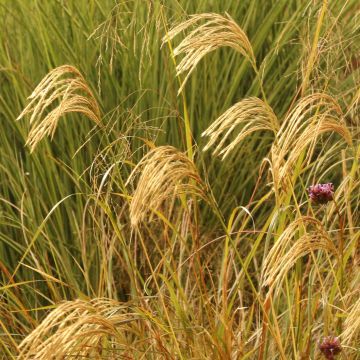
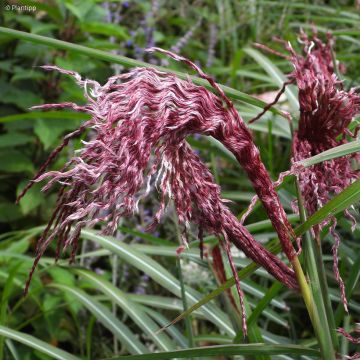
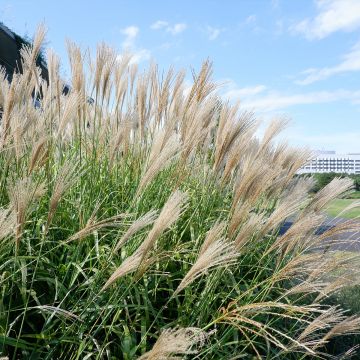

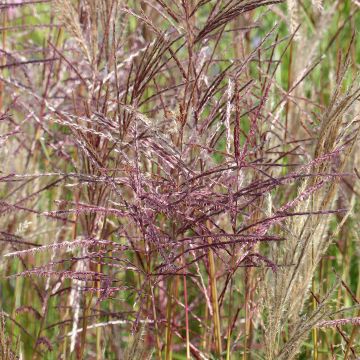

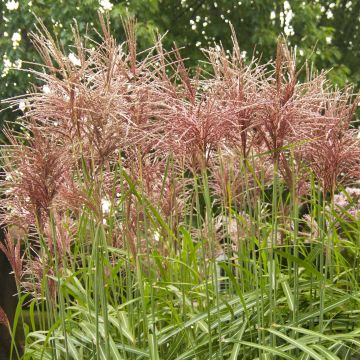
Comments